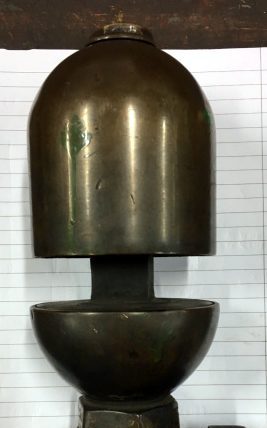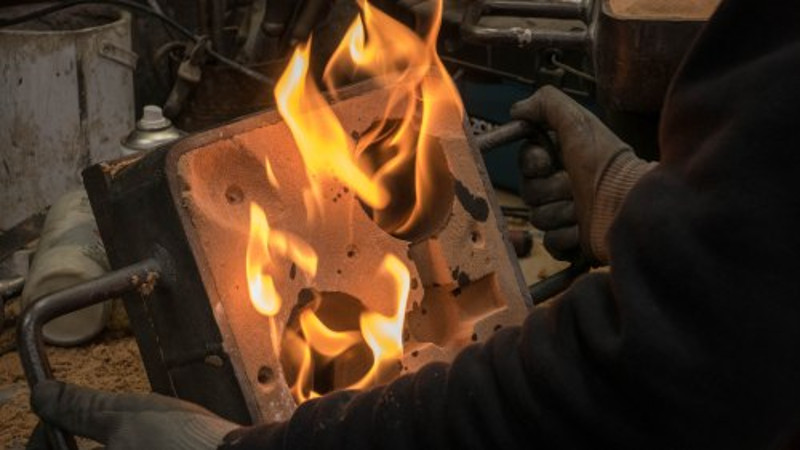Late last year, artist [Steve Messam]’s project “Whistle” involved 16 steam engine whistles around Newcastle that would fire at different parts of the day over three months. The goal of the project was bring back the distinctive sound of the train whistles which used to be fixture of daily life, and to do so as authentically as possible. [Steve] has shared details on the construction and testing of the whistles, which as it turns out was a far more complex task than one might expect. The installation made use of modern technology like Raspberry Pi and cellular data networks, but when it came to manufacturing the whistles themselves the tried and true ways were best: casting in brass before machining on a lathe to finish.
 The original whistles are a peek into a different era. The bell type whistle has three major components: a large bell at the top, a cup at the base, and a central column through which steam is piped. These whistles were usually made by apprentices, as they required a range of engineering and manufacturing skills to produce correctly, but were not themselves a critical mechanical component.
The original whistles are a peek into a different era. The bell type whistle has three major components: a large bell at the top, a cup at the base, and a central column through which steam is piped. These whistles were usually made by apprentices, as they required a range of engineering and manufacturing skills to produce correctly, but were not themselves a critical mechanical component.
In the original whistle shown here, pressurized steam comes out from within the bottom cup and exits through the thin gap (barely visible in the image, it’s very narrow) between the cup and the flat shelf-like section of the central column. That ring-shaped column of air is split by the lip of the bell above it, and the sound is created. When it comes to getting the right performance, everything matters. The pressure of the air, the size of the gap, the sharpness of the bell’s lip, the spacing between the bell and the cup, and the shape of the bell itself all play a role. As a result, while the basic design and operation of the whistles were well-understood, there was a lot of work to be done to reproduce whistles that not only operated reliably in all types of weather using compressed air instead of steam, but did so while still producing an authentic re-creation of the original sound. As [Steve] points out, “with any project that’s not been done before, you really can’t do too much testing.”
Embedded below is one such test. It’s slow-motion footage of what happens when the whistle fires after filling with rainwater. You may want to turn your speakers down for this one: locomotive whistles really were not known for their lack of volume.
When we first covered this project, we knew that the whistles were reproductions that operated on compressed air rather than steam, but little was known about the challenges involved or the background of the project. [Steve] has shared details in three parts: an overview, details about the locations chosen, and information on the whistles themselves.
















Fascinating. Had no idea how tricky they were to machine. Clever to use it as an apprentice’s training.
I have made organ pipe style flutes, that is the embouchure is not lips but like an Irish whistle. At one stage of assembly I have the bottom with it’s air slit in one hand and the pipe with it’s flattened knife edge in the other hand. When I align them and blow thru it, it is silent till I am right on less than the width of the air slit relative to the top. I try it out looking and testing to be sure where it needs to go. Then fast setting epoxy and do it again one more time for good, then set it upside down to cure.
I never have to turn down my sound per warnings from users of YouTube, this one was still minus 2 dB. It was clipped in the recording and I am puzzled as what the “undertones” are, they are digital in nature. Steam would have that spitting a little moisture that air doesn’t have anyway.
Talk about lost technologies, hardly any YouTube videos have proper audio level. Just like any normal radio station (not the Orban modulators at max) you are not getting heard well unless up in the upper half of that meter. My first exposure to a reel tape recorder and many after was “it’s all about level and watch that meter” or magic eye tube in the really old ones. When you record and process to upload sound in the digital domain you need to use all the bits starting with recording. If there is no level control like most phones-tablets remember that mic feed is good to go for close speech not a demo talk at 2 or 3 feet away or a loud band. Audacity can normalize the audio of an AVI file, no need for a video editing suite.
Odd timing in that the latest Humble Bundle is “Computer Music” and of course that includes audio signal processing.
https://www.humblebundle.com/books/computer-music-books
.
Youtube videos are normalised to ITU-R BS.1770.
The video sounds like it’s been slowed down a lot. Duplicating the sound of a steam whistle with air is very difficult due to the water vapor and temperature of steam. Steam whistles have a ‘hollow’ sound to them, a bit dull/smooth, less sharp than air whistles.
“Embedded below is one such test. It’s slow-motion footage of what happens when the whistle fires…”
thank goodness; somebody can read
Great build! I miss the foundry work even though most everything I did was lab or engineering related. Have some kit ready and so far am thinking pouring recycled aluminum RF cases for modules. I recently came across a great series of casting videos and since was just turned onto the casting cement 3D printed method…, I’ll drop a tangential somewhat though similar more to this article metal casting form making method here:
https://www.youtube.com/watch?v=HVgPM1ojyLw
I need a 5-1/2 ” valveless whistle bowl. Cody